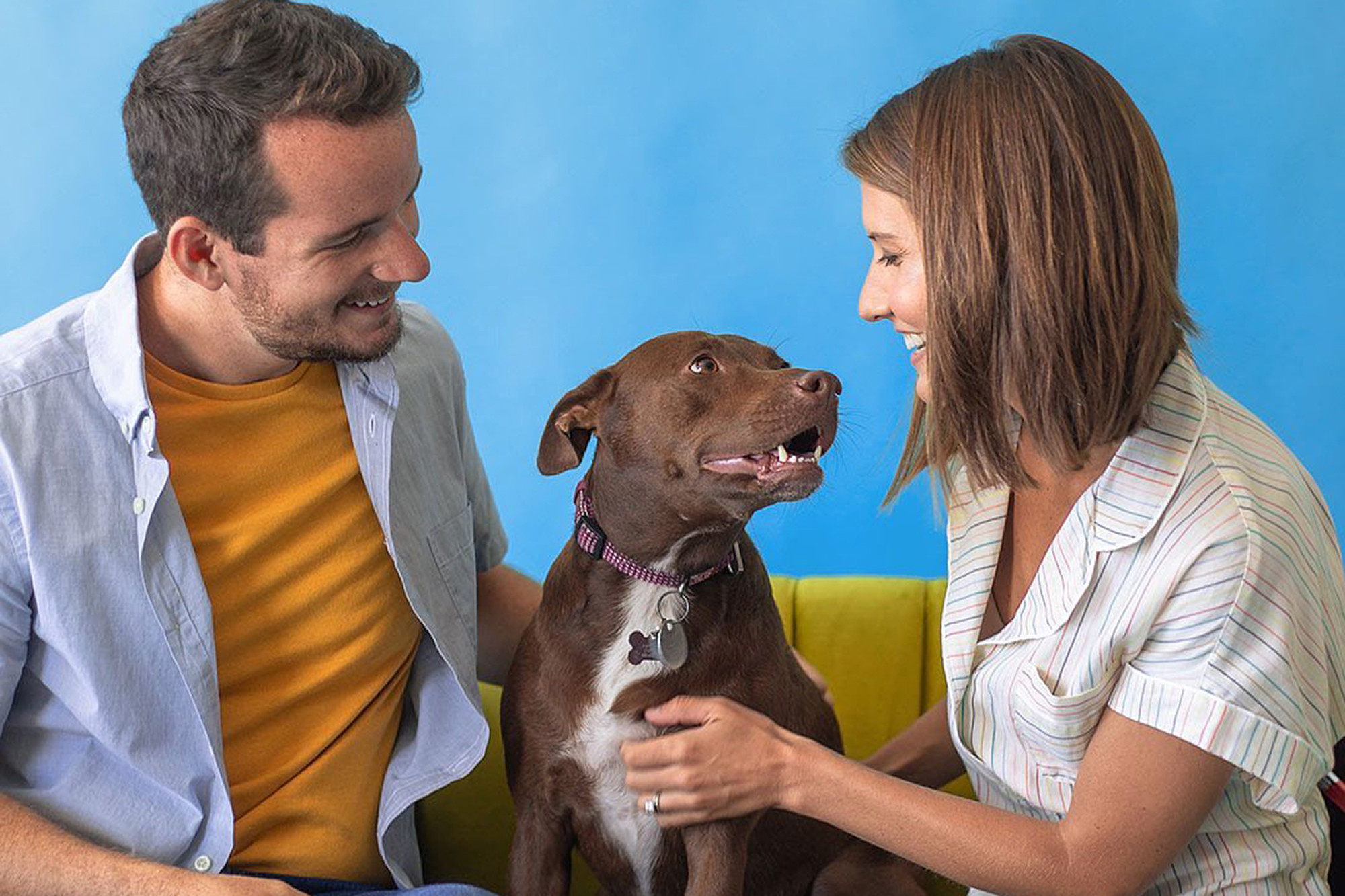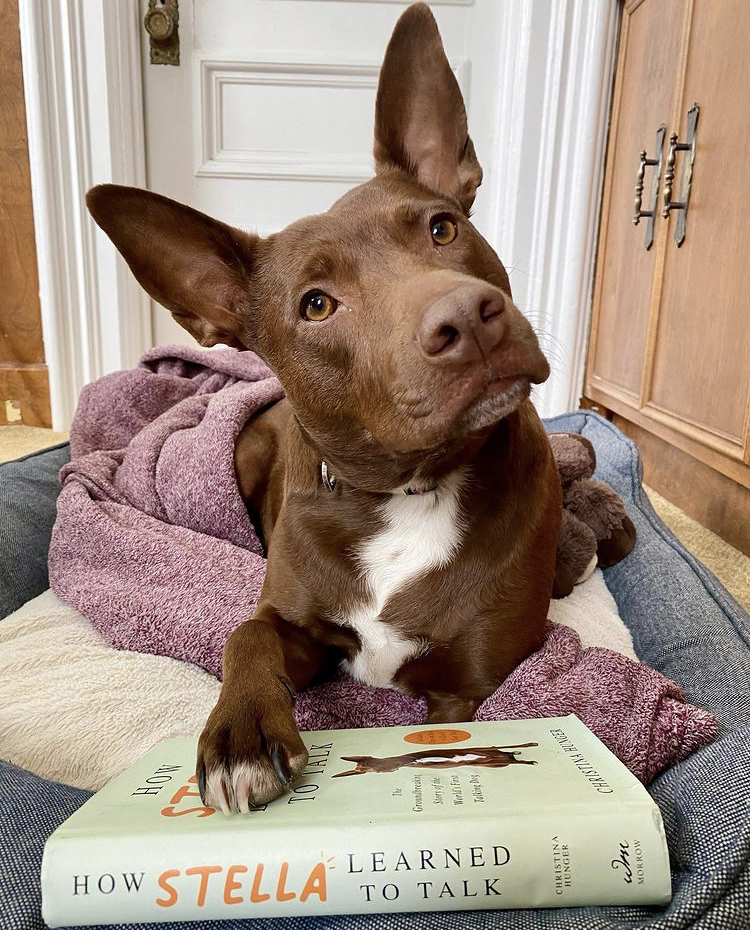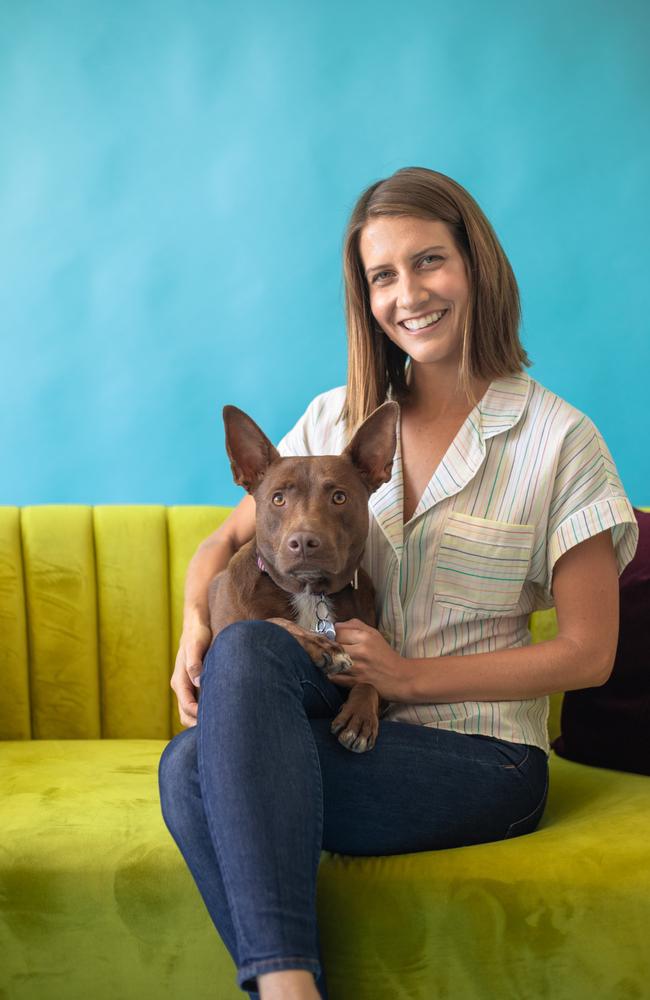Your dog is already a skilled communicator– gesturing to fill up his water dish, rolling on his back to cue you for belly rubs, or barking and whining to get your attention.
These not-so-subtle behaviors tell you what your dog wants and needs from you while serving as an inspiration for the potential for learning and communicating!
When Christina Hunger began teaching Stella how to talk, she didn’t realize this real-world experiment would inspire every animal lover today.
Here’s the briefest of introductions to the most sensational of stories.
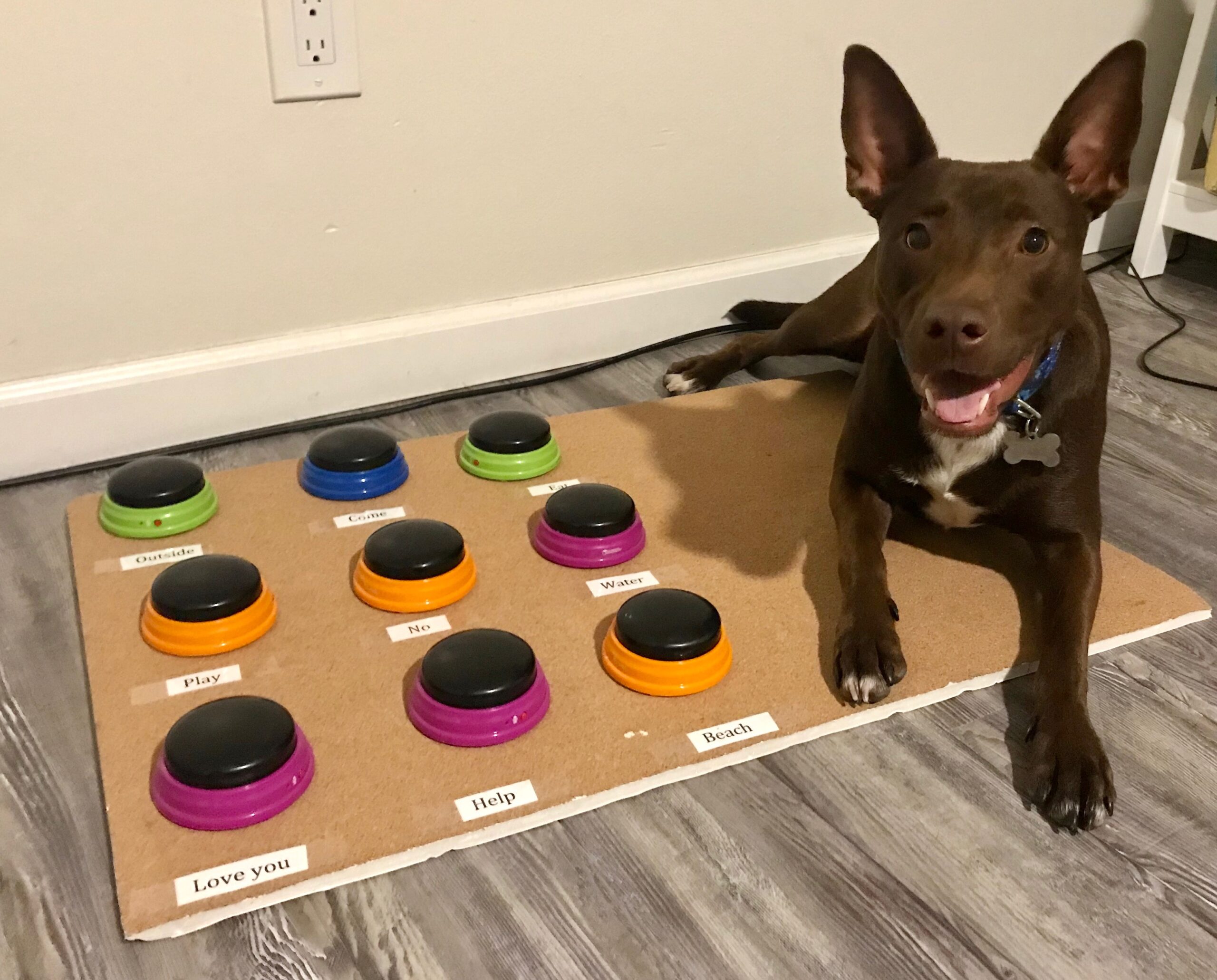
On The Agenda
How It Started
Christina Hunger was in her first year as a speech-language pathologist working with children who were learning how to use a communication device to talk. Using augmentative and alternative communication (AAC) tools gives people with disabilities, or severe speech delays the ability to say words using a different medium.
This approach is progressive even for those in the field of speech pathology, but it’s an exciting opportunity for those who are misunderstood.
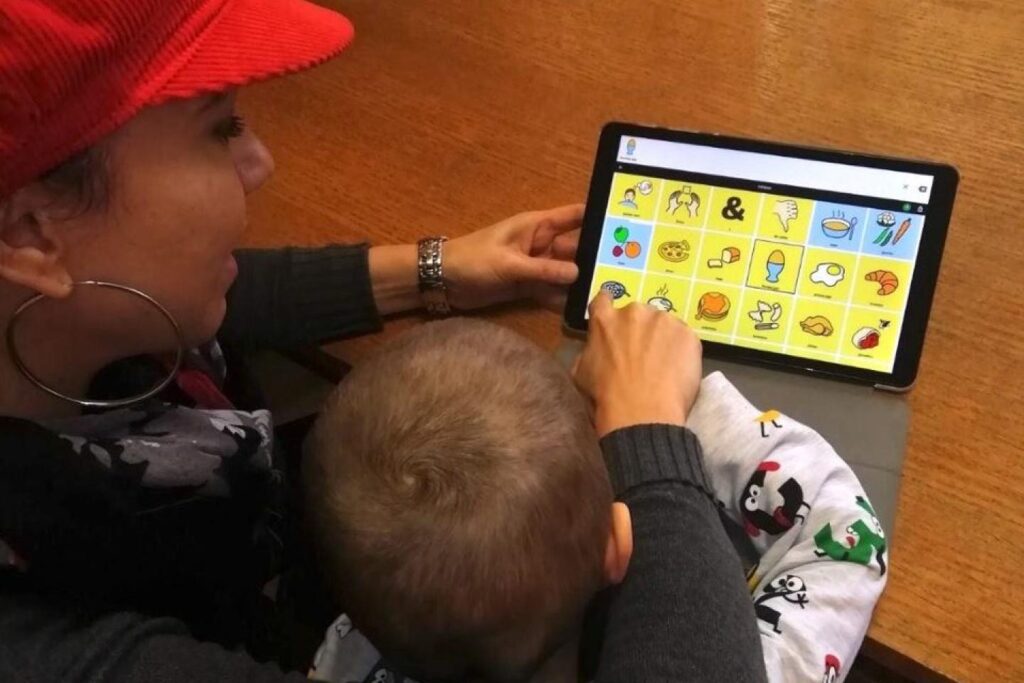
Christina was (and continues to be a fierce advocate for AAC), so when she noticed parallels of a child’s language development in her new big-eared pup, Stella her curiosity was piqued.
At only eight weeks old, Stella was checking off each skill used for learning and language– gesturing, cueing, vocalizing, eye contact.
Seeing these milestones of prelinguistic communication skills, Christina asked herself the one question that would catapult this entire movement in animal communication, “If dogs can understand the words humans say to them, shouldn’t they be able to say them back to us?”
Christina’s initial plans were to teach Stella a few words to give her a way to tell them what she wanted and needed.
She used speech therapy techniques to teach her puppy words.
She started with two of the most evidence-based speech therapy techniques: aided language input and focused language stimulation. Put simply, you can make huge strides in language development by changing the way you talk to a child and by how often you model words at the right time.
It’s important to distinguish that Christina didn’t train her dog to hit a button for a treat. She used the same techniques she’d used as a speech therapist to teach children and applied them to teach her dog words.
Again, why this story is so completely and utterly mind-boggling and why you should read the book yourself.
She began with one button– “outside.” After a week and no progress, it actually inspired Christina to program two other buttons – “water” and “play.”
Since she already had experience teaching language and introducing an AAC system to a child, she tried an approach that had long been gaining traction among communication experts. This idea that greater exposure leads to greater learning. So, the more vocabulary available to work into her routine, the faster Stella would learn.
And it worked. So well, in fact, that her language exploded. And with it the start of not only verbal communication in dogs but a revolution in language.
What It Became
Over the course of two years, Stella has added over 45 words to her vocabulary. A vocabulary consisting of verbs, nouns, adjectives, and names.
She regularly uses question words to say what she wants to do, comment on what they are doing, and what they’ve done.
She says what she likes, dislikes, what makes her happiest, when her pet parents are being good, answers questions, even creates her own unique short phrases.
She’s involved in conversations. She gives her opinions about where and what they’re going to do in a day. She means what she says and voices that even without her buttons by lying down when Christina tries to deviate from plans they make.
What Stella and Christina Taught Us
Christina gives every one of us an opportunity to communicate with our dogs in a more profound and meaningful way. And Stella confirms time and time again that dogs do have so much to say.
Reflecting on her and Stella’s journey, there were countless insights to gain, but three big takeaways rewired my way of thinking and how I view communication.
Everyone Deserves A Voice

“Communication shouldn’t be conditional… The point of teaching language is not to hear what we want to hear when we want to hear it. We teach words to empower others to share their own thoughts, whatever and whenever they may be.”
We could take a step back to listen to our dogs’ thoughts, to give them a voice in the conversation. Imagine what you’d learn about your dog if she had one more tool to express herself.
Every Animal Is Intrinsically Motivated To Communicate
Everyone assumes– even the author initially– that once a dog knew how to say words, it would just be treat, treat, treat. Having that eat button available would overpower the ability to learn that she could use her words for anything other than getting food.
But the author makes such an obvious and perceptive point– if Stella wasn’t constantly using nonverbal behaviors like sitting by her bowl all day to ask for food before, why would she do it now that she could use a word like eat?

Stella was intrinsically motivated to communicate. Meaning, her drive to communicate came from this innate desire to do something rather than to do it for a reward.
“[Stella] had so much to say and so badly wanted to communicate with us about the world we were all living in together.”
Stella’s intrinsic motivation was so strong that it drove Stella to learn the new locations of her buttons after Christina reconceptualized her board to grow her vocabulary.
She needed her words to express herself and share her thoughts. Her communication skills had grown so much that she couldn’t go back.
Communication Is Everywhere
As Christina eloquently puts it, “communication is everywhere if you know where to look for it.”
As a speech pathologist, Christina is uniquely positioned. She’s acutely aware of the forms of communication exchanges that others may miss.
- Body language
- Gestures
- Vocalizations
- Reactions to words

The time it takes to process spoken language vs body
While we may never rival the skills of perception Christina has, we can vastly improve on what we do have. It’s as simple as being a little bit more present in the moment and looking for it.
You can do it now– look at body language, facial expressions, reactions. Not just of your dog, but be more perceptive of friends, workmates, strangers. Communication is everywhere when you know where to look.
A Revelation in Animal Communication
Stella’s story is nothing short of remarkable. It’s confirmation that, yes, dogs ARE complex thinkers with communication skills astoundingly similar to humans. It opens up this vast realm of possibility, a field of study with so many more questions to be answered. Research is already underway, with thousands of participants who were inspired by another talking dog, Bunny.
And for every pet lover reading this, it’s the opportunity we’ve all wanted. To know what that wiggling rump next to you is thinking. Maybe they only tolerate the burrito costume they’re stuffed into a few times of the year. Or they’d prefer to go to the park rather than the beach because squirrels are more of a challenge to chase than the seagulls.

Teaching your dog words gives you this tremendous opportunity to learn more about their thoughts, personality, and to connect in a profound way.
I found myself underlining and highlighting passage after passage, scribbling little notes and exclamations in the margin. And when I closed the book, I bought a pack of buttons because I want in on this!
I have a husky who says plenty already, but I know he’s thinking so much more and that all he needs is the tools. With just a few buttons and a bit more patience, I can peer deeper into that complex noodle of his.
The potential is unlimited, possibilities endless, and the best part, we’re in it together. Me and my dog.
So go! You can get your dog to communicate, too. Just get your buttons and your book, and it will guide you, give you insight, inspire you as you work to communicate in an entirely new way with your dog.
This is by and large the most thrilling exploration into language and inter-species communication since the groundbreaking work of Jane Goodall. And you and your dog could be out at the forefront of it all. Dog only knows what your pup has to say!
Whether you’ve just ordered your buttons or are already well underway on your journey, share your story in the comments below!
Share this Post
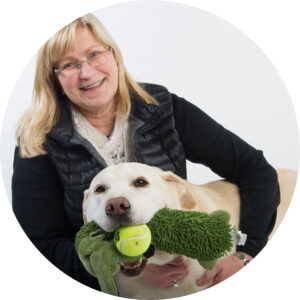
Dr. Chris Besent
Chris Bessent, DVM, MSOM, Dipl. OM, L.Ac. has over thirty years of experience in veterinary medicine including certificates in veterinary acupuncture, veterinary chiropractic and veterinary Chinese herbology. Imbued with Eastern philosophy and the knowledge that food is the foundation of health, Dr. Bessent also received her degree in veterinary nutrition and began to formulate recipes fit for a carnivore from nothing but whole foods. Currently, she divides her time between the Simple Food Project and Herbsmith, both of which are owned and operated out of her facilities in southeastern Wisconsin.

Kayla Behling - Editor
Kayla is the Content Editor for Herbsmith. She has a cat named Professor Cat-Faced Meowmers, who goes by Kitty, and a goof of a dog, named Duck. She stays busy biking trails, playing board games, and searching for the next best craft beer.
